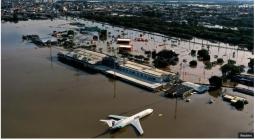EAST AFRICA: floods in the first half of 2024

Climate change has been dictating the law in East Africa for some years now. The first six months of 2024 were no exception, with an increase in the number of floods taking a heavy economic and environmental toll on the countries affected.
For a long time, the main concern for the populations of Kenya, Somalia, Ethiopia, Tanzania and Burundi was drought. For some years now, they have had to cope with a succession of torrential rains that trigger spectacular floods along the way. The first half of 2024 was particularly bleak for many families in East Africa.
According to a report by the United Nations Office for the Coordination of Humanitarian Affairs (OCHA) consulted by Afrik21, the consequences of the floods between January and May ranged from the destruction of houses and fields to the loss of livestock. This damage has led to the displacement of many households (480,000 people in the Horn of Africa) in search of new places and means of subsistence.
“Humanitarian partners in East Africa continue to support governments in search and rescue operations, assessing needs, pre-positioning available stocks and providing emergency assistance. Additional funding is needed to scale up interventions as the floods continue”, says Ocha.
Very alarming figures
A case in point is Tanzania, where rising waters combined with landslides have killed 155 people in the space of a week. The scenario was worse in Somalia, where nine people were killed, seven schools and more than 3,000 shelters were damaged in 13 districts, including Bulo Burto, Jalalaqsi and Jowhar. Burundi has not escaped this biannual series of floods in East Africa, which is exacerbating the current cholera epidemic (1,631 confirmed cases) in the country. “More than 10% of the country’s food-growing areas have been devastated”, laments the United Nations Office for the Coordination of Humanitarian Affairs (OCHA).
And there’s more to come, as the UN’s humanitarian experts are already predicting “above-average rainfall for the period from June to September 2024” in the region. This will also affect Djibouti, Eritrea, central and northern Ethiopia, as well as “a large part of South Sudan and Sudan”, warns Ocha, which fears that Lake Victoria will rise to record levels as a result of “the Niño climate phenomenon”.






